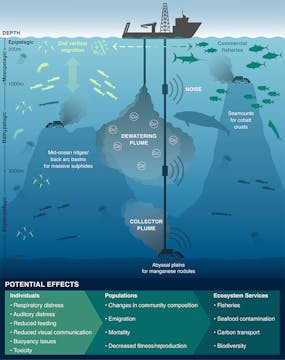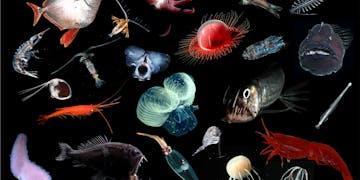Interest in mining the deep seafloor for copper, cobalt, zinc, manganese, and other valuable metals has grown substantially in the last decade. In some areas, metallic nodules are scattered on the seafloor. Elsewhere, precious metals valuable to the technology industry are found in hydrothermal chimneys. These finds have created a "gold rush" of sorts in the deep sea.
The International Seabed Authority (ISA), which regulates mining in international waters, has already issued 30 exploration leases in an area of about 1.5 million square kilometers (about580,000 square miles). Some countries are also exploring mining of the seabed in their own waters.
But harvesting this treasure could harm another natural treasure—the rich abundance of life on the deep seafloor and in the water column above. The deep midwaters of the world ocean make up the largest habitat on Earth. They contain 100 times more fish than the annual global catch, connect surface and seafloor ecosystems, and play key roles in climate regulation and nutrient cycles.

Illustration (not to scale) showing some of the potential effects of deep-sea mining on midwater animals. Image courtesy of the University of Hawaii.
To collect the valuable minerals from the seafloor, mining companies use a sort of vacuum to pull up the metallic nodules, along with the silt and water surrounding them. The material is brought to a ship at the surface, where the minerals are removed, and the byproduct silt and toxicant-enriched fluids are discharged back toward the seafloor. The process is also extraordinarily noisy.
Each mining ship is estimated to discharge between two million and 3.5 million cubic feet of sediment and water every day. Some, but not all, of the discharge will make it back to the site of the mining extraction, which itself will remain scarred for years. The materials that don’t settle to the seafloor create plumes that do not remain within a certain boundary in the ocean—scientists project some of the sediment may drift hundreds of miles with ocean currents. Nothing will prevent it from traveling to areas purportedly set aside for protection from mining. For instance, the regulatory buffer zone around some South Pacific islands is only about 90 kilometers (about 50 nautical miles), which is not likely to protect the surrounding reefs or local fisheries and tourism from the discharged sediments.

Most research assessing the impacts of mining has focused on the seafloor and the habitat immediately adjacent to extraction activities. MBARI has joined scientists worldwide pressing for a more comprehensive study of the risks. In 2020, MBARI Senior Scientist Steve Haddock and colleagues, including former and current MBARI postdoctoral fellows Jeff Drazen, Anela Choy, and Astrid Leitner, brought light to these concerns in a publication for the journal Proceedings of the National Academy of Sciences (PNAS).
Under
the UN Convention on the Law of the Sea, the ISA is required to ensure
the effective protection of the marine environment, including deep
midwater ecosystems, from harmful effects arising from mining-related
activities. Drazen, the lead author on the PNAS study, and his
coauthors are urging researchers and governing bodies to expand midwater
research efforts, and adopt precautionary management measures now, to
avoid harm to deep midwater ecosystems from seabed mining.
Decades of deep-sea research by Haddock, MBARI Senior Scientist Bruce Robison, and their colleagues have shown that many water-column organisms feed on particles or on other organisms that are particle feeders—these include midwater worms, snails, salps, larvaceans, and even vampire squid. These animals are part of a complex food web that connects all the way to humans. In addition to clogging the animals’ filtering mechanisms and adding non-nutritious or toxic material to these animals’ diets, the sediment would absorb the blue-green light that glowing deep-sea animals use to attract prey, search for food, and find mates.
In keeping with MBARI’s Strategic Plan, which calls for informing policy makers and resource managers with the science needed to make decisions, Haddock and Choy (now a professor at Scripps Institution of Oceanography) elucidated the issues related to deep-sea mining in an op-ed piece in the New York Times.
Haddock and Choy pointed out that wealthier companies and countries stand to benefit from the mining operations, but it will often be the smaller countries that rely on the ocean for their livelihoods that suffer the consequences. They called for a reduction of the impact of mining operations, and reminded the public and policy makers that deep-ocean ecosystems are fragile and diverse treasures in their own right, and worth protecting.
